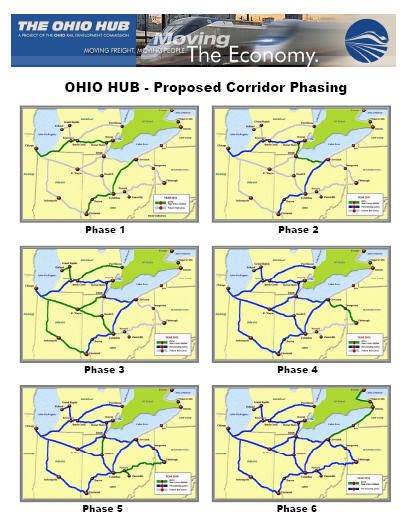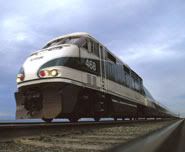 ... or Virginia or Illinois or upstate New York or North Carolina or Washington and Oregon or ...
... or Virginia or Illinois or upstate New York or North Carolina or Washington and Oregon or ...... well, any other state except Ohio. Outsourcing Ohio's HSR jobs to other states is a central plank of John Kasich's run to become Governor of Ohio.
Of course, we don't expect people from places like Lehman Brothers to flat out say something like that: instead, they give a plausible sounding sound bite which then falls apart the minute you think about it. Their hope, it seems, is that nobody thinks about it.
So too with Kasich's plan to hand Ohio's $400m in HSR Stimulus Funds back to the Federal Government for another state to use ... he hides his plan behind a red herring.
________________________________
The Background to the Story
Once upon a time, in the 1980's, before the neoliberal trade policy pursued by Bush and agreed to by Clinton shipped Ohio's manufacturing economy overseas, there was an ambitious plan to build a bullet train system for Ohio. It was to be supported by an increase in the state sales tax. It got onto the ballot, and then was voted down.
 Fast forward to the 90's. While the Clinton administration lobbied hard to signed President George H.W. Bush's NAFTA agreement into law, it also pushed through a High Speed Rail bill that set up a system of state based High Speed Rail commissions, with enough funding to basically fix up a few of the most dangerous level crossings around the country. Ohio got its High Speed Rail Commission, and went back to the drawing board.
Fast forward to the 90's. While the Clinton administration lobbied hard to signed President George H.W. Bush's NAFTA agreement into law, it also pushed through a High Speed Rail bill that set up a system of state based High Speed Rail commissions, with enough funding to basically fix up a few of the most dangerous level crossings around the country. Ohio got its High Speed Rail Commission, and went back to the drawing board.Fast forward to the turn of the 21st century. Under the aggressively anti-rail Resident George W. Bush administration, some states took the lead in promoting incremental improvements to passenger rail, and through a merger with other state rail authorities to form the Ohio Rail Development Corporation, Ohio's "Ohio Hub" plan continued to take shape.
Fast forward to a major lurch of US transportation policy into the final third of the 20th century, $8b in HSR funds were approved as part of Stimulus II, after the Stimulus I under Bush of tax cuts alone failed to prevent the recession that started in 2007 from spiraling down into the worst recession since the two recessions that made up the Great Depression.
Republicans in control of Ohio's State Senate prevented the state from applying for a 110mph corridor between Cleveland, Columbus, Dayton and Cincinnati, but the Strickland state administration was able to wrest agreement to a 79mph "starter line", which would get service started and which could be upgraded by ongoing incremental investment to be converted into a 110mph corridor.
And Ohio won $400m in funding. It is presently negotiating the agreement with the FRA to use $25m for final planning and design, leaving $375m to break ground in Spring of 2011.
Kasich Against Jobs In Ohio
Now, it would normally be hyperbole to say that a candidate for Ohio governor is actually opposed to the creation of jobs in Ohio. I have lived through lots of gubernatorial elections, and normally both candidates are for jobs.
But really, Kasich wants those jobs to go out of state. From Cleveland Scene Weekly
Republican gubernatorial challenger John Kasich is no fan of rail either. His camp didn't respond to interview requests for this story, but a news clip posted on his website about Ohio rail studies is headlined "Train Already Wasting Taxpayer Money." And he said earlier this year that the $400 million Ohio received for rail would be better spent on Ohio's roads and bridges.
But it can't be: The funds are specifically attached to rail. If Kasich becomes governor in November and decides to kill the 3C project, Ohio's money will go to other states. With California, Florida, and the Pacific Northwest, among others, ramping up to build their stimulus-funded routes, someone else will be waiting in line to take the money Ohio leaves on the table.
The 2009 work (pdf) of the American Public Transport Association gives the following job impacts per million dollars for capital works in public transport:
- Direct job creation, 8.2/$m
- Indirect (upstream) job creation, 7.8/$m
- Induced (downstream) job creation, 7.7/$m.
Now, working out the Indirect job creation impact of the Kasich policy to hand the money back for use by another state is tricky ... it requires untangling which upstream spending will leave Ohio in any event, and which upstream spending will stay in Ohio in any event. So I will focus on just the direct jobs, which of course are taking place in Ohio on the 3C corridor, and the induced effect.
Assuming that $25b is spent to do final planning and design, and then Kasich cancels the project, that means $375m is handed over for use by another state. That means:
- $375m x 8.2 direct jobs/$m = 3,075 direct jobs lost; and
- $375m x 7.7 induced jobs/$m = 2,887 induced jobs
So its roughly 6,000 jobs that Kasich wants to outsource to another state.
Big Deal, its only 6,000 Jobs
The immediate protective reaction is, well, its only 6,000 jobs. Why, with Ohio's 10.5% headline unemployment rate, 6,000 jobs is surely just a drop in the bucket. Ohio has 625,000 unemployed ... 6,000 is less than 1% of our total unemployed workforce.
But of course, this is just one policy. Kasich summarizes his four main policy platforms as:
- lower taxes
- Make government more effective
- Transform Our Educational System and
- End the Influence of Special Interests
The first three seem likely to translate into sacking state employees and cutting assistance to local governments forcing them to sack local city, country and village employees, some more sacking of state employees with outsourcing of their jobs to private corporations (and if those private corporations outsource work out of state, well, that would be consistent), and cut public school budgets forcing them to sack teachers.
As far as ending the influence of special interests ... who is it backing Kasich's policy of handing as much of the $400m HSR money back to some other state?
But that award was also met with opposition from the Ohio Contractors Association, the Ohio Trucking Association, and the Ohio Petroleum Marketers and Convenience Store Association — all of them highway-dependent groups
So as far as "ending the influence of special interests" goes, that would seem to be code for, "swapping one set of special interests for the special interests that are backing me".
But, what about the problems with the Starter Line
One thing the Conservative echo chamber excels in is spreading unbacked, empty, but plausible sounding talking points far and wide. The main talking points for the 3C starter line are:
Among their criticisms: Building a rail line will require expensive state subsidies and will never be self-supporting, and train speeds will be so slow and they will run so infrequently that they won't attract ridership. Besides, they add: Nobody in Ohio wants to ride trains anyway.
 The argument about the train being slow often goes, "we should jump straight to HSR". And, indeed, if it would have been supported by the Republican State Senate, it certainly should have been.
The argument about the train being slow often goes, "we should jump straight to HSR". And, indeed, if it would have been supported by the Republican State Senate, it certainly should have been.But that is a red herring. From today, surely the fastest route to a 110mph HSR 3C line is to build the starter line, starting to run in late 2012, and upgrade distinct individual segments to 110mph, cutting trip speed, increasing patronage, and reducing subsidies with each segment upgraded until we have a 110mph 3C line with average trips of 70mph to 80mph and with sufficient frequency that there is no need for surpluses. Cutting the corridor into four segments, two segments per year would see a 110mph corridor by 2016, while one segment per year would see a 110mph corridor by 2018.
How much faster would the "leapfrog the Starter Line" be? With the $400m for the Starter Line in hand, Ohio can get started. After turning the money back, certainly a Kasich administration could not apply for a more ambitious project, so that would be 2011-2014 lost, at least a year for an incoming Democratic governor taking over to clean up Kasich's mess before attention could be turned to it, and then finding money for a state match, since going ahead, a 20% state match looks to be required for Federal HSR capital grants. So maybe 2016 to apply, 2017 to begin construction ... 2018 to finish the 110mph HSR 3C corridor under the "leapfrog" plan would be optimistic.
So, the "leapfrog" would mean getting the HSR corridor no sooner, probably later, and doing without increasingly rapid intercity passenger rail for at least six years. More like a "leap-tortoise" plan.
Conclusions
Well, none of this is surprising. Strickland loses the Governor's race if Buckeyes vote the fact that the economy sucks, Kasich loses the Governor's race if Buckeyes vote the fact that under Kasich it will suck much worse.
More to the point is to fight the talking points that the opponents will be spreading in letters to the editors and newspaper sites across the state. Just Google ""Ohio High Speed Rail" in news.google.com on a regular basis, and look for the Ohio based newspapers:
- Giving the money back means about 6,000 jobs heading off to another state
- The "40mph" starter line is designed from the start for the upgrade to cruise at 110mph ~ once its in place, Ohio is in place for a series of Federal HSR funds to do the upgrade, and each upgrade will boost ridership and cut the subsidy
- The ridership study is based on the assumption of cheap gas: if there is another oil price shock, ridership will explode
Midnight Oil ~ Dreamworld


1 comment:
thats the trend nowadays outsource even if you dont need to
Post a Comment